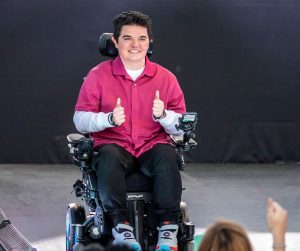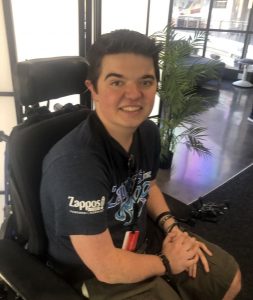Duchenne Teen Hits the Runway at Las Vegas Fashion Show

Joey Chorzewski, 18, gives a thumbs-up at the Runway of Dreams fashion show in Las Vegas. (Photos courtesy of the Chorzewski family)
Joey Chorzewski has Duchenne muscular dystrophy, a neuromuscular disease that makes him different from most of his peers in Marshfield, Massachusetts. But in other ways — like wanting to wear the same kind of clothing his friends wear — he’s a typical teenager.
Thanks in part to the nonprofit Runway of Dreams Foundation, Joey and other people with disabilities may soon have more fashion options.
Besides offering a variety of programs and awareness campaigns, the New Jersey-based foundation recently co-hosted its Zappos Adaptive and Runway of Dreams Foundation Fashion Show featuring 30 models with different disabilities. A collaboration with Zappos Adaptive — a division of the online retailer that markets to people with disabilities — the livestreamed March 27 event in Las Vegas spotlighted the future of adaptive fashion.
At the show, Joey, 18, maneuvered the runway in his motorized chair wearing dressy black pants with elastic around the bottom of the legs, a red shirt with hidden magnets instead of buttons, and athletic shoes with zippers and Velcro. His mother, Denise Chorzewski, said in a phone interview that the Nike outfit, which the show provided, had been adapted by Zappos.
At the foundation’s June 2018 show — which kicked off Fashion Week in New York City — Joey wore a gray fleece jacket with Velcro in the back. Because it was his first modeling gig, he was admittedly nervous. His second show, though, was “exciting.” In fact, he called it the best day of his life.
“Everything was great,” said Joey, who graduates from high school this month. “My teachers all congratulated me and everything.”
Under a large tent before the show, he and others mingled and had their hair and makeup done. There was food and drinks, and Zappos provided a volunteer to help each participant. Then, Joey motored down the outdoor catwalk in front of 2,000 spectators, stopped, did a thumbs-up with both hands, and turned around.
“When he came out, I was like, ‘wow,’ ” his mother said. “I was in tears. And to see how brave all the kids are. It was awesome, more inclusive than anything we’ve experienced.”
A future in modeling?
The whole modeling concept sprung from the teenager’s desire to wear jeans and, well, anything other than the myriad sweatpants he has just because they’re easier to handle.
Joey’s parents do what they can to help him feel more fashionable, including having jeans or khakis professionally fitted with elastic. But that’s time-consuming and expensive. As it is, he uses a combined standing sling and lift to help him get his pants on. Because he can’t raise his weakened arms that high, pullover tops are also a problem.
His mom had gotten wind of the adaptive wear shows, and she thought it was something her outgoing son would enjoy, even though Joey had no modeling experience.
“I wanted to show that people with disabilities can wear fashionable clothes too,” she said, recalling how 15 people were selected out of 500 applicants.
Chorzewski hopes to model again next year. An only child who was diagnosed with Duchenne at age 3, he’s always been a bit of a ham. When he was younger, he used to act on stage in plays.
“It made him feel alive,” his mom said. “He would smile the entire time.”
But when he turned 12 and began using a wheelchair, Joey didn’t want to perform anymore. Still, he remains active. He enjoys his friends, likes to travel and watch movies, and is a bit of a food critic.
Joey could soon receive a robotic arm; the family awaits an insurance decision on that. Besides his medications, the teenager has physical therapy three times weekly.
Adaptive clothing is big business
Despite Duchenne’s progressive nature, it’s not the disease itself that occasionally gets Joey down. When he’s feeling sad, it’s usually about not being included.
Feeling better about his clothing could help. His parents have ordered from Zappos’ adaptive line, and plan to order more. The division offers everything from “wheelchair friendly” shoes and clothing to “treatment wear.” Adaptations include snaps and hooks instead of buttons, adjustable hems on shirt sleeves, pant legs for those with limb disparities, and back-of-dress openings that let patients dress independently.
The industry is already big business. According to consultants, the global market for adaptive apparel could reach nearly $289 billion worldwide this year, and $350 billion by 2023.
A few years ago, after collaborating on Runway of Dreams, Tommy Hilfiger — in partnership with Zappos — introduced an adaptive apparel line. Other major brands, including Target and Nike, have since joined the fray. Yet many mainstream retailers overlook these prospective customers, leaving medical supply firms as the chief source of specialized clothing.
Mindy Scheier estabished the Runway of Dreams Foundation in 2015 after her young son, Oliver — who has a rare form of muscular dystrophy — couldn’t understand why he could not wear jeans like other boys did.
Scheier, a fashion industry veteran, knew that sweat pants fit nicely over Oliver’s leg braces and enabled him to use the bathroom on his own. So she decided to alter a pair of jeans for him.
The foundation states on its website: “Through adaptive clothing donations, employment opportunity initiatives, adaptive design workshops, awareness-building campaigns and scholarship programs, the Runway of Dreams Foundation is empowering people with opportunity, confidence, independence and style.”
As for Joey, his life philosophy is sanguine.
“It’s just good to stay happy,” he said. “You only live once, so make the most of it.”









